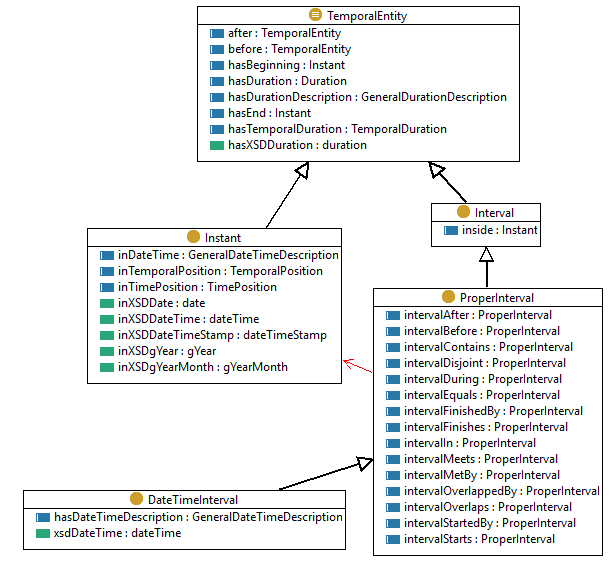Temporal Coverage
Namespace Prefix: geosci-time
Namespace URI: http://schema.geoschemas.org/contexts/temporal#
- Classes
- Properties
- Using OWL Time
Classes
none
Properties
geosci-time:temporalCoverage - Use the OWL-Time vocabulary to describe the temporal coverage of a Dataset.
Domain: schema:Dataset Range: time:TemporalEntity
geosci-time:radiocarbonCalibrationCurve - For defining the ‘Radiocarbon Calibration Curve’ temporal reference system for use in OWL-Time.
Domain: time:Instant Range: xsd:string
The radiocarbon calibration curve used to determine the BeforePresentCalibrated date. Some examples are “INTCAL99”, “INTCAL04”, “INTCAL09”, “INTCAL13”, and “INTCAL20”.
geosci-time:geologicTimeUnitAbbreviation - Geologic time unit for use in OWL-Time
Domain: time:TemporalEntity Range: xsd:string
Standard time unit abbreviation for the age. BP, BP-CAL, ka, Ma, Ga are used for before present, before present calibrated, thousands of years, millions of years, and billions of years respecitively.
geosci-time:uncertainty - For defining the ‘Uncertainty’ in a geologic age/date for use in OWL-Time.
Domain: time:TemporalEntity Range: xsd:decimal
The uncertainty in the value of the geologic age in the same units as the age. Usually expressed in the literature using the symbol ± before the value. One should always pair this with UncertaintySigma when the sigma of the uncertainty is known.
geosci-time:uncertaintySigma - For defining the ‘Uncertainty Sigma’ in a geologic age/date for use in OWL-Time.
Domain: time:TemporalEntity Range: xsd:decimal
The sigma of the uncertainty of the geologic age. 1 for one-sigma uncertainties, 2 for two-sigma uncertainties, etc. For easy reference, sigma values to three decimal places for uncertainties of some widely used confidence levels are: 1.645 for a 90-percent confidence level, 1.960 for a 95-percent confidence level, and 2.576 for a 99-percent confidence level.
geosci-time:uncertaintyOlder - For defining the ‘Uncertainty Older’ in a geologic age/date for use in OWL-Time.
Domain: time:TemporalEntity Range: xsd:decimal
If the uncertainties of an age are not symmetric around the age value, as is usually the case when Baysean methods are used, one can specify the older and younger uncertainties of the age value. One should always pair uncertaintyOlder with uncertaintyYounger. In addition, uncertaintySigma should always be used when the sigma of the uncertainty is known.
geosci-time:uncertaintyYounger - For defining the ‘Uncertainty Younger’ in a geologic age/date for use in OWL-Time.
Domain: time:TemporalEntity Range: xsd:decimal
If the uncertainties of an age are not symmetric around the age value, as is usually the case when Baysean methods are used, one can specify the older and younger uncertainties of the age value. One should always pair uncertaintyYounger with uncertaintyOlder. In addition, uncertaintySigma should always be used when the sigma of the uncertainty is known.
Using OWL Time
The OWL Time vocabulary defines useful ways for describing the temporal coverage. The temporalCoverage of a Dataset indicates the period of time that the contents of the dataset apply. This extension to schema:Dataset allows for the description of temporal coverages that cannot be described using a ISO 8601 formatted date (and time). Some examples of such coverages are geologic time scales, seasonal coverages across multiple years, or certain days of the week. The coverage is expressed as a time:TemporalEntity, typcially a time:Interval or a time:Instant. OWL Time in RDF Turtle

Intervals
Simple Date Time Temporal Coverage
To express an interval of time as the coverage for a schema:Dataset, schema.org provides the schema:temporalCoverage which allows for defining a coverage using ISO Example: Expressing a time interval using a time:TemporalEntity
{
"@context": {
"@vocab": "http://schema.org/",
"time": "http://www.w3.org/2006/time",
"geosci-time": "http://schema.geoschemas.org/contexts/temporal#"
},
"@type": "Dataset",
...
"temporalCoverage": {"@value": "2019-03-31T00:00:00Z/2019-04-30T06:00:00Z"},
"geosci-time:temporalCoverage": {
"@type": "time:TemporalEntity",
"time:hasBeginning": {
"@type": "time:Instant",
"time:inXSDDateTimeStamp": "2019-03-31T00:00:00Z"
},
"time:hasEnd": {
"@type": "time:Instant",
"time:inXSDDateTimeStamp": "2019-04-30T06:00:00Z"
}
}
}
Durations
Sometimes, the temporal coverage of a Dataset is measured as a duration in time. For example, let’s say the Dataset is the most recent data starting two weeks from the time the data is requested. Such a duration can be expressed as:
{
"@context": {
"@vocab": "http://schema.org/",
"time": "http://www.w3.org/2006/time",
"geosci-time": "http://schema.geoschemas.org/contexts/temporal#"
},
"@type": "Dataset",
...
"geosci-time:temporalCoverage": {
"@type": "time:TemporalEntity",
"time:hasDuration": {
"@type": "time:Duration",
"time:unitType": { "@id": "time:weeks" },
"time:numericDuration": { "@value": 2.0, "@type": "xsd:decimal" }
}
}
}
Seasonality
Seasonality should work when https://github.com/w3c/sdw/issues/1140 is completed. For now, the original idea for describing is defined below.
A dataset that collected measurements every Summer between 2012 and 2015. For discovery, if a data searcher was more interested in data collected during the Winter, a dataset with measurements in the summer can be excluded to improve precision and recall. Conversely, searchers looking for data in the Summer months is enabled.
A table of the begin and end dates of data collection from 2012 to 2015.
| Year | Begin | End |
|---|---|---|
| 2012 | 2012-06-30 | 2012-09-09 |
| 2013 | 2013-07-06 | 2013-09-03 |
| 2014 | 2014-07-03 | 2014-09-06 |
| 2015 | 2015-06-29 | 2015-09-04 |
To describe a seasonal coverage, we define the full temporal coverage using the first and last date of collection
Temporal Coverage: 2012-06-30 to 2015-09-04
Then, we use the time:intervalContains property to describe the begin and end date of each year for this full temporal coverage.
{
"@context": {
"@vocab": "http://schema.org/",
"time": "http://www.w3.org/2006/time",
"geosci-time": "http://schema.geoschemas.org/contexts/temporal#"
},
"@type": "Dataset",
...
"temporalCoverage": {"@value": "2012-06-30/2015-09-04"},
"geosci-time:temporalCoverage": {
"@type": "time:ProperInterval",
"time:hasBeginning": {
"@type": "time:Instant",
"time:inXSDDate": "2012-06-30"
},
"time:hasEnd": {
"@type": "time:Instant",
"time:inXSDDate": "2015-09-04"
},
"time:intervalContains":[
{
"@type": "time:ProperInterval",
"time:hasBeginning": {
"@type": "time:Instant",
"time:inXSDDate": "2012-06-30"
},
"time:hasEnd": {
"@type": "time:Instant",
"time:inXSDDate": "2012-09-09"
}
},
{
"@type": "time:ProperInterval",
"time:hasBeginning": {
"@type": "time:Instant",
"time:inXSDDate": "2013-07-06"
},
"time:hasEnd": {
"@type": "time:Instant",
"time:inXSDDate": "2013-09-03"
}
},
{
"@type": "time:ProperInterval",
"time:hasBeginning": {
"@type": "time:Instant",
"time:inXSDDate": "2014-07-03"
},
"time:hasEnd": {
"@type": "time:Instant",
"time:inXSDDate": "2014-09-06"
}
},
{
"@type": "time:ProperInterval",
"time:hasBeginning": {
"@type": "time:Instant",
"time:inXSDDate": "2015-06-29"
},
"time:hasEnd": {
"@type": "time:Instant",
"time:inXSDDate": "2015-09-04"
}
}
]
}
}
See: https://github.com/schemaorg/schemaorg/issues/1186#issuecomment-226838348